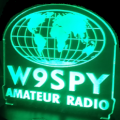ChrisSmolinski
About
- Username
- ChrisSmolinski
- Joined
- Visits
- 3,882
- Last Active
- Roles
- Member
- Points
- 5
-
Block a frequency
-
v1.443: automatic SNR measurement, queue/camp panel reload button, misc fixes
-
Keep your ground connections short if you want them to work
Earlier today I got an email from an SWL with a KiwiSDR & AirSpyHF+. He was complaining about very high noise / RFI levels, even though he lives in a rural area much like myself (he was comparing his noise levels to what he sees when using one of my online KiwiSDR receivers).
We exchanged a few emails back and forth, so I could understand his setup. He has a 80 ft T2FD and 500 ft sky loop antenna, so comparable to some of my antennas. I asked him if the coax shields were grounded, he said yes. OK, I asked how.
"I have a very nice ground it is a 8-ft rod into the ground and it is connected with the 12 gauge copper wire to the coax cables."
I explained that the connection from the ground rod to coax shield needs to be as short as possible. Ideally a few inches. How long is it? If it is many feet long, the inductance will be high, and it will not work as a good ground connection.
"Apx 12 feet".
Hmm... So he shortened that to 9 inches, and reported the RFI levels dropped down to as low as if no antenna was connected to the radio. Ideal background noise levels.
He was pretty happy 😀
So the moral of the story is, if you want your ground to work, you need to keep the connection to it as short and low inductance as possible.
-
v1.403: colormap improvements, multiple DRM schedule databases
-
Problem with massive RFI after changing router
A few suggestions, you may have already tried some of them, but here goes... (I assume you have one of those integrated routers/modems)
Disconnect the coax cable and ethernet cables from the cable company router/modem, unplug the power supply from the AC, make sure the RFI completely goes away, this may sound redundant, but double checking this is really the problem.
Plug the AC power supply into the wall, but leave it disconnected from the router/modem. Does the RFI re-appear? Is it the same as before? This checks just the PSU for RFI issues.
Plug the PSU into the router/modem, leave other cables disconnected. What's the RFI like?
Plug in the coax cable for the router/modem. Again... what's the RFI like?
Start plugging in ethernet cables (not sure how many computers you have connected). Maybe plug in just one end at a time, first the router end, then the computer end. Note RFI levels. Repeat for any additional cables.
The point of all this step by step stuff is to figure out what is producing the RFI and (maybe) how it is radiating.
It is quite possible there is not one step that produces the RFI problems you see, but it is the summation of multiple sources/problems, this lets you figure out what is what.
At some point in these steps, you may even want to try something as silly as wrapping the PSU and/or modem in a giant sheet of aluminum foil (possibly connected to ground say via a piece of wire with alligator clips). Not permanently of course, but as a test. If that solves the issue, the you can think of a creative way to do that permanently while still providing enough ventilation, etc.
You can also try grounding various parts of the equipment, such as the router. And also try using shielded ethernet cables, but that only works if the stuff you're plugging the cables into actually has metallic ports. Lots of cheap stuff is all plastic, so there's nothing for the shield to connect to, it just floats, and is useless. If it's at least grounded on one end, that may help.
Another suggestion... you (generally) do not need to use the cable company's garbage (there are lots of reasons why you SHOULD NOT, beyond RFI). I use my own modem and my own routers. You may want to do the same. It's probably cheaper to buy them yourself than trying to fix an RFI issue with lots of expensive ferrite and other stuff. Plus you won't be paying a monthly rental fee for their junky equipment that is full of security risks






